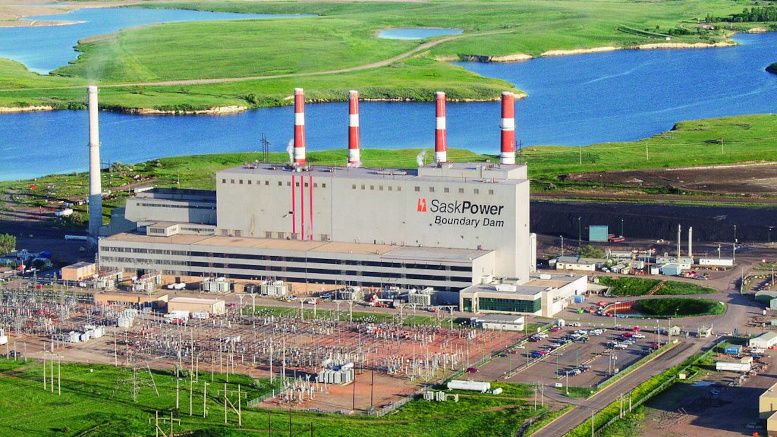A joke currently doing the rounds: “Definition of a fossil fool — A politician who spends $9.1 billion on an emission reduction plan while spending twice as much to expand a tar sands pipeline.” No prize for identifying the fool in question.
The foolishness is underlined by the recent report from the Intergovernmental Panel on Climate Change (IPCC) which makes grim reading. One of the report authors, said: “It’s now or never, if we want to limit global warming to 1.5C. Without immediate and deep emissions reductions across all sectors, it will be impossible.” Yet the Liberals want to double down on their folly of increasing the production and export of fossil fuels while aiming to “mitigate” emissions in the extraction of oil and gas. A key part of the plan to reduce carbon emissions is by burying them in the ground. It’s known technically as carbon capture and storage (CCS). More commonly it’s called being in a hole and digging deeper.
Stung by criticisms from environmentalists and others regarding Canada’s consistent failure to meet targets on carbon emissions, the Trudeau government appears to be making more of an effort to appear less of a fool. The $9.1 billion dedicated to its plan is the amount that the government announced, at the end of March, in a plan that earmarks this sum for a range of climate programs. For the first time, it is spelled out how possible greenhouse gas reductions from various sectors of the economy could allow Canada to hit its 2030 emissions target of at least 40 percent below 2005 levels. Chief among them is the oil and gas sector, the top source of greenhouse gas pollution in the country. The plan projects the sector to be able to slash emissions by 42 percent below 2019 levels by 2030.
Big oil
Justin Trudeau said the expected reduction is “reasonable,” and, interestingly, put it in terms of a move away from the corporate influence of the fossil fuel industry. “Big oil lobbyists have had their time on the field,” he said. “Now it’s over to the workers and engineers.” From this you’d think that Big Oil was about to be taken down. If only! Under the Trudeau plan, they will continue to produce and pollute.
As Socialist Alternative has explained, the Liberal’s plan is to increase oil and gas production and exports while reducing the emissions in the production process, so they can claim that Canadian emissions have declined. But most of the carbon is released not in production but when the fuel is burned. Gun makers claim it is not their fault that the guns are used to kill people. The Liberals will claim it is nothing to do with them if the oil they export is burned!
The Alberta tar sands are one of the dirtiest and most expensive sources of oil. Research from 2015 concluded that 85 percent of tar sands reserves needed to stay in the ground if Canada was going to stay within its then carbon budget and contribute to avoiding 2 degrees of warming. The understanding was that tar sands’ companies could continue current production until 2025 at the latest. Not dealing with the tar sands would be game over in the struggle to avoid dangerous climate change.
Imperial Oil in January announced that its oil sands’ greenhouse gas emissions intensity is expected to decrease by 30 percent compared with 2016 levels. It “plans to achieve this through implementation of lower greenhouse gas next generation technologies, efficiency improvements at its facilities, and the use of carbon capture and storage.” But note the caveat contained in a footnote to this statement: “Imperial’s actual results may differ materially from those expressed or implied by its forward-looking statements and readers are cautioned not to place undue reliance on them.” As if we would!
The Canadian Association of Petroleum Producers (CAPP) said the sector should contribute to the country’s climate goals and help other countries reduce emissions by selling them more Canadian oil and gas! CAPP states that “a stable and globally competitive business environment for all enhances investment, creates jobs, promotes innovation and enhances our ability to reduce emissions.” But it doesn’t! Canadian exports of energy products, mostly crude oil and bitumen have posted an annual increase of 56.4 percent between 2021 and 2022. The country exported $15.39 billion worth of these commodities in February 2022, compared to $9.84 billion in the same month last year. “Exports of crude oil (+9.9%) contributed the most to the growth in February 2022, largely due to higher prices,” Statistics Canada reported.
According to Economic Dashboard, the West Texas Intermediate price of oil, often a world reference price, averaged US $108.50 a barrel in March 2022, 74.1 percent higher than it was a year earlier. Western Canada Select, the price obtained for many Alberta producers of oil, averaged US $94.57 a barrel in March 2022, 85.6% higher than it was a year earlier. The increase in the price of oil, caused largely by the war in Ukraine, has led to a bonanza for the western oil capitalists. When profit gouging is this easy, why would they listen to environmentalists urging them to stop taking oil from the ground by 2025? They’ll respond by arguing that all their emissions are going to be magically captured.
Does carbon capture work?
Carbon capture is problematic to say the least. It aims to remove carbon dioxide either from the atmosphere in general or more frequently proposed from the exhaust gases of industrial processes such as gas and coal-fired electricity generating plants, steelmaking, and industries that convert natural gas to hydrogen (so it can be re-classified as a clean fuel). Once removed, the CO2 is stored most commonly by converting it into a liquid and pumping into underground rock formations that can be sealed for generations to prevent the carbon escaping back into the atmosphere.
Pumping liquid CO2 underground was first used in the 1970s, to increase the amount of oil extracted from wells. Even today most captured carbon is used to increase oil production. It wasn’t until the 1980s that carbon capture technology was studied for climate mitigation efforts, and even then only haphazardly.
Removing the CO2 is a complex and expensive process, and many schemes proposed in the 1990s were abandoned as they were too expensive or technically difficult. A 2021 report from the Tyndall Centre for Climate Change Research says: “The technology still faces many barriers, would only start to deliver too late, would have to be deployed on a massive scale at a scarcely credible rate and has a history of over-promising and under-delivering.”
At a recent gathering of scientists working on carbon capture in Britain two-thirds were either “not confident” or saw “no chance” of Britain reaching its 2030 targets for greenhouse gas removal and tree planting. They stressed that countries “must drive down emissions.”
Carbon capture and storage (CCS) is expensive and unproven. In 2021 there were only 26 CCS plants operating globally, capturing about 0.1 per cent of the annual global emissions from fossil fuels. The two CCS projects currently operating in Alberta rely on significant public funding. It is estimated that the average cost of a big project in Canada is currently $1 billion for a megatonne per year. “So if Canada is serious about meeting its own target or 15 megatonnes per year of captured and stored carbon annually, it will require approximately $15 billion of spending between now and 2030.”
SaskPower has a carbon capture system on its Boundary Dam coal-fired plant. However, it has faced many problems, both financial and environmental. Even eight years after the capture was installed, it still has on-going problems. Hardly a recommendation for carbon capture. According to the International Energy Agency, in 2021 it was the only such plant in operation worldwide.
Trudeau has only set aside $9.1 billion for all components in his plan. Will big oil make up the difference? They certainly have the profits. Calgary-based CNRL made $7.66 billion in profits on $30.1 billion of revenues in 2021.
What about the trees?
The planting of trees is what most people associate with carbon capture. Undoubtedly, more trees will improve soil and water conservation, store carbon, moderate local climate by providing shade, regulate temperature extremes, increase wildlife habitat and improve the land’s capacity to adapt to climate change. One large tree can provide a day’s oxygen for up to four people. It takes about 500 full-sized trees to absorb the carbon dioxide produced by a typical car driven 20,000 km/year. One large tree can lift up to 100 gallons of water out of the ground and discharge it into the air in one day.
The 2 Billion Trees program (2BT) is part of the Canadian government’s plan for “mitigating climate change while achieving key biodiversity, conservation, and human well-being benefits.” Launched in February 2021, the government claims that the program is on track to plant two billion trees over 10 years. By the end of 2021, 30 million trees should have been planted, but in November 2021, the program had reached less than half that goal. The program claims that the number will increase every year. The global organization managing the one trillion trees by 2030 program is part of the World Economic Forum whose stated aim is “to bring together decision-makers from across society to work on projects and initiatives that make a real difference. Through collaboration between stakeholders with varied perspectives, our projects deliver concrete and sustainable results and make a positive impact at all levels of society.” This is the same organization that provides a platform for a group of billionaires, elite philanthropists and western leaders to meet every year in Davos, Switzerland to discuss the problems of the day (facing capitalism) in a relaxed atmosphere.
The limitations of tree planting
On the website of 1 trillion trees, there is the question “can we solve climate change by planting trees?” The answer given is “No, absolutely not.” They go on to say: “to address climate change we must first rapidly and significantly decarbonize across all sectors of industry and economic activity.” That is stating the obvious. However, there is a darker side to tree planting. “The problem is, too often, tree-planting is perceived as a feel-good cure-all for global warming. In the U.S., conservative leaders like former President Donald Trump have touted tree-planting while working to eliminate emissions regulations.”
The actual planting of trees is easy enough. The problem arises from location (urban vs rural?) and maintenance over the lifetime of the growing trees. Copenhagen launched in 2015 a program to plant 100,000 new trees by 2025 and the commitment was pitched as a key part of its plan to reduce carbon emissions. After six years, many of the saplings had died. “People bash into them with bikes and cars,” says Sandra Hoj, an urban tree campaigner in the city, “and they often don’t have proper protection.” “The city is still replacing some beautiful mature trees with tiny little twigs, which die, are replanted, and then die again.” In other words, another failure of capitalism. Feel good projects are just that — short-term, warm and fuzzy feelings are generated but they don’t carry through to get the job done. For that, you need a plan that has been drawn up by experts with full consultation from working-class organizations and communities to decide on implementation — the type of trees to plant, where to plant them and how to maintain them over a 20-30-year period.
Another case was arid Los Angeles, with former Mayor Antonio Villaraigosa having the ambitious goal of planting one million trees in four years. “As many as 700,000 of the million trees needed to be planted on private property because space elsewhere was tight which meant that the maintenance and watering largely fell on residents. The city hosted public giveaways. But some residents took fragile seedlings, only to then leave them sitting on their patios or balconies. The city also partnered with local non-profits to plant trees along median strips, in school yards and in low-income communities where tree cover was sorely lacking. But planting street trees on private property — which required landowners’ participation and, in many cases, a commitment to water them for the first five years — proved difficult, according to a study on the program.” Another case of failed capitalist planning.
Socialist Alternative supports all means that will tackle climate change. Clearly, we are in favour of “natural” carbon capture in the form of tree planting. Under certain circumstances, we might also be open to the use of more “artificial” carbon capture methods. For the latter, the question to ask is why use energy intensive and expensive methods to capture emissions that shouldn’t be put out in the first place? The simplest and first priority must be to switch from fossil fuels to renewable energy — wind, water, solar and geothermal are all in plentiful supply. This would also reduce pollution and provide many rewarding jobs. It is clear is that a major program of tree planting or reducing carbon releases requires democratic socialist planning. This system is bust, the solutions proposed and half-implemented are incapable of dealing with the climate crisis. We need a root and branch change, a socialist change.




